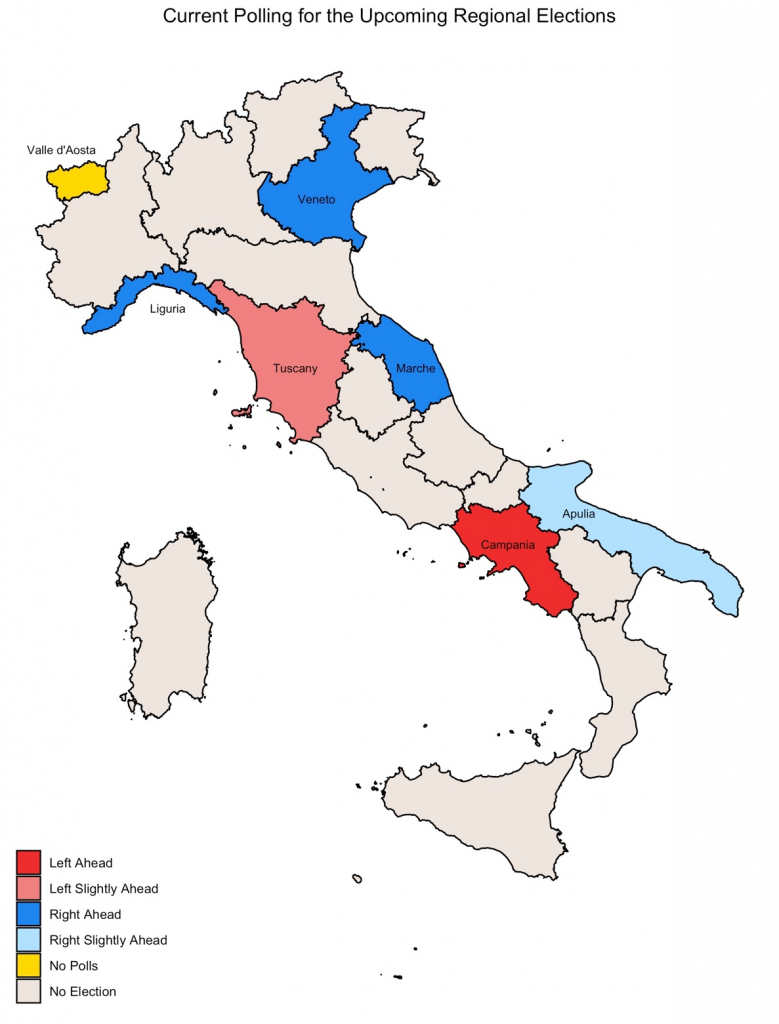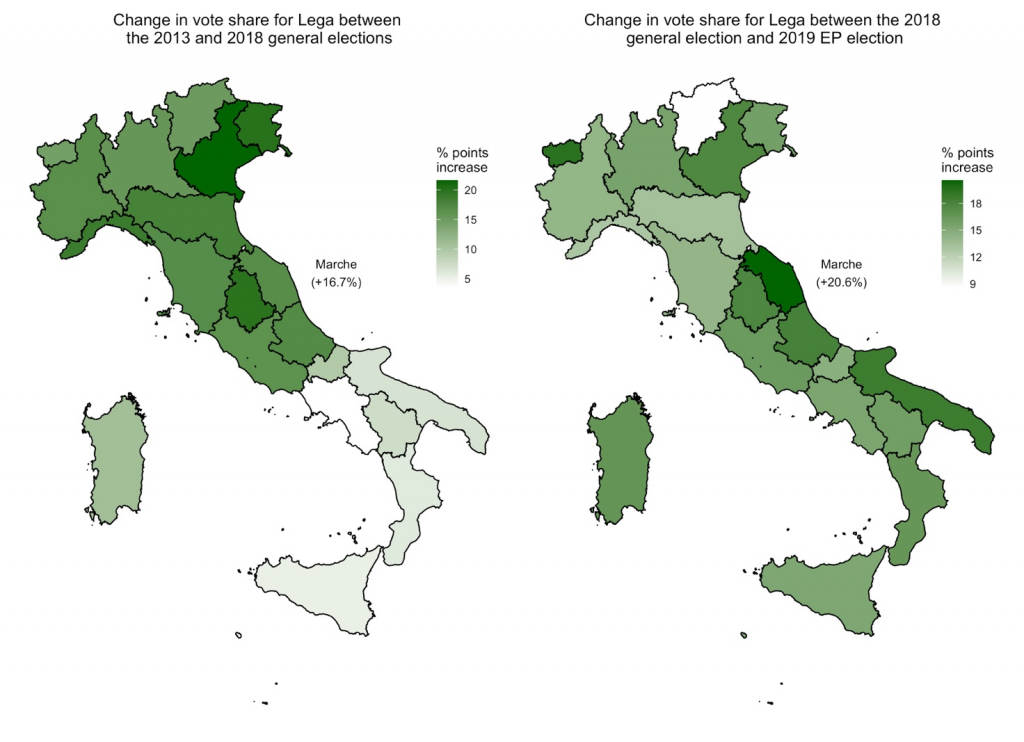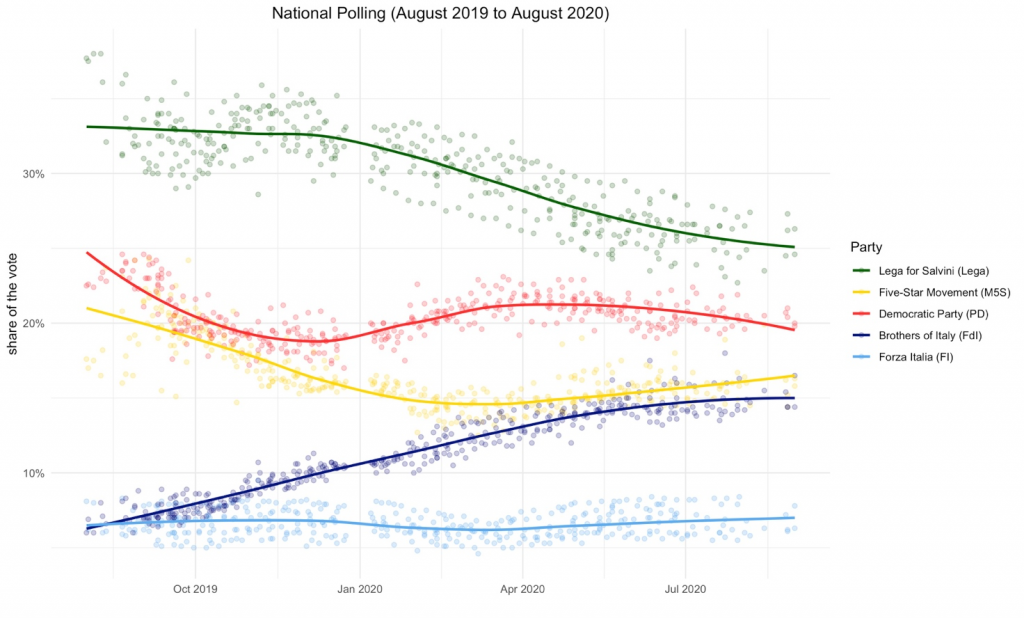 Italy will hold a series of elections and a constitutional referendum on 20-21 September. Leonardo Carella previews the votes and highlights some of the key things to watch out for when the results come through.
Italy will hold a series of elections and a constitutional referendum on 20-21 September. Leonardo Carella previews the votes and highlights some of the key things to watch out for when the results come through.
On 20-21 September, Italians will head to the polls to vote for the presidency of seven regions, the mayoralty of over 1,100 municipalities, two Senate by-elections, and a constitutional referendum over the reduction of the number of MPs. The ballot, held over two days, comes as the first democratic test for the government following the Covid-19 outbreak and subsequent lockdown, which disrupted plans to hold some of these elections earlier this year. The massive ‘election day’ has already given authorities headaches in terms of ensuring the safety of the procedures, as well as drawing criticism for using school facilities as polling places, cutting short what for many pupils will be the second week back in the classroom since March.
The constitutional referendum is the only vote on which all the country will have a say. The proposal to reduce the number of MPs in the Chamber of Deputies from 630 to 400 and Senators from 315 to 200 is widely expected to pass, though with a low turnout and with little enthusiasm. The measure, sponsored by the largest government party, the Five-Star Movement (M5S), has no real opponents outside of a few very vocal Twitter accounts: parties of the right have expressed lukewarm support for it, while the centre-left junior coalition partner, the Democratic Party (PD), has remained neutral. The latest IPSOS poll, published on 4 September on Corriere della Sera has ‘Yes’ at 71%, with a turnout estimate of 52%.
Conversely, the national conversation has so far focused intensely on the regional elections in Campania, Liguria, Marche, Apulia, Toscana, Valle d’Aosta and Veneto. These votes are a big deal: regions have extensive powers on key policy areas like healthcare, infrastructure, agriculture and education, and the seven that will vote make up more than a third of Italy’s population. Moreover, regional presidents have been some of the most visible policy-makers during the coronavirus crisis, and it is expected that their performance will weigh heavily on voters’ decisions alongside judgements of the national response.
Figure 1: Current polling for the upcoming regional elections
Note: Compiled by the author.
But ultimately regional elections always have a strong national political significance. The electoral system, which returns a clear winner with a guaranteed majority, encourages voters and commentators to think of regional contests in party political terms, as high-stakes horse races. In short, voters cast two ballots: one for a coalition of parties supporting a candidate for the presidency and one for an individual party. The highest-polling coalition gets the presidency, 80% of seats in the regional council are attributed proportionally according to party votes, plus a 20% top-up that ensures that the winning coalition holds a majority in the council.
If regional elections are a thermometer of national party standings, Italy is in the grip of a right-wing fever. Since the last general election, the coalition of the right – headed by radical right parties Lega and Brothers of Italy (FdI), plus Silvio Berlusconi’s Forza Italia (FI) – snatched the presidency from PD in eight out of nine regional races, with the M5S trailing the two main coalitions by miles in virtually every election and plummeting into single-digits in the last two.
Figure 2: Presidential coalitions in Italian regions
Note: Compiled by the author.
Although regional election polls in Italy are notoriously unreliable, this time around the left can be reasonably confident of holding onto the presidency of Campania. The southern region is not historically their home turf, but here the PD can count on an unlikely saviour: incumbent regional president Vincenzo De Luca. A colourful character with a dozen court cases to his name and ostensibly a relic of the reviled partitocrazia of old – he became secretary of Salerno province’s Communist Party chapter in 1975 – De Luca is wildly popular in his home region.
Much of De Luca’s appeal is due to his sheriff-like handling of the response to the coronavirus, which saw footage of him threatening to send police to stop unauthorised gatherings “with flamethrowers” go viral on social media. Yet his unconventional style seems to have worked: Naples province has 3 million people and is one of the most high-density areas in Europe, but it only registered 4,000 Covid-19 cases. And the polls are clear that the ‘meme president’ is comfortably leading his main rival, former regional president Stefano Caldoro (FI), by over 20 points (Winpoll, 27 August).
Campania President De Luca, armed with a flamethrower, features as the main character in an arcade-style online game where he incinerates university graduates wishing to celebrate unauthorised and potentially infectious graduation parties.
Holding onto the presidency of Marche is poised to be a much harder task for the left’s coalition. Though sometimes considered part of the ‘Red Belt’ in Central Italy, Marche is one of the regions where Lega has made the most inroads since it expanded its appeal beyond the North, and was the epicentre of anti-migrant violence in the run-up to the 2018 election. The PD incumbent is stepping down, and the right is supporting a Brothers of Italy candidate, Francesco Acquaroli.
The polls have Acquaroli ahead by somewhere between eight (Istituto Noto, 25 June) and fifteen percentage points (Winpoll, 25-27 August). All in all, the race seems to be a re-run of the right’s triumph of last October in Umbria: a mid-income former left-wing heartland peppered with small towns, politically and demographically very similar to Marche. Matteo Salvini and Giorgia Meloni’s ‘new’ right has been more successful than its Berlusconi-led predecessor in winning over areas like these – often building, as argued in a recent working paper by Moreno Mancosu and Riccardo Ladini, on a pre-existing far-right ‘minority political culture’ in the Red Belt.
Figure 3: Change in support for Lega in Italian regions
Note: Compiled by the author.
The presidency of Tuscany, however, would be the right’s most highly prized target: wealthier, more urban and more left-leaning than Marche, former PM Matteo Renzi’s home region has been ruled by left-wing administrations for all 50 years of its existence. But this time, Lega’s candidate, Susanna Ceccardi, has a genuine shot at breaking the streak. Earlier this summer, polls had the left’s candidate and current speaker of the regional council, Eugenio Giani, leading Ceccardi by three to six points, but a poll published by Winpoll on 1 September had the gap down to just half a percentage point. The possibility of a run-off – Tuscany’s twist on regional election rules requires a second round if no coalition reaches 40% of the vote – seems unlikely at this point, as the left and right have largely squeezed the M5S’s vote.
It is hard to overstate how shocking it would be for Tuscany to fall to the right, and even a narrow victory for the left shouldn’t be of much comfort to the PD and its allies. However, the precedent of Emilia-Romagna, another ‘core’ Red Belt region that had its election in January this year, suggests caution: there, some polls even had the right slightly ahead, but the left won by seven points on election day. A similar result in neighbouring Tuscany, with Giani and the left eking it out in the end, is still the most likely outcome.
Alongside Tuscany, the other close regional election is in Apulia, where incumbent Michele Emiliano faces MEP Raffaele Fitto (FdI), freshly acquitted of corruption charges related to his tenure as president of Apulia between 2000 and 2005. In this case, the left has been working pretty hard at self-sabotage. Emiliano, a former member of the PD now running as an independent, has alienated the ‘centrist’ components of the left’s coalition (Renzi’s Italia Viva and liberal +Europa), who are running their own candidate against him. At the same time, while Emiliano is close to the M5S on many issues – his opposition to the TAP pipeline, his support for judicial activism and crucially his burning hatred of Matteo Renzi – attempts to form a joint list with the M5S fell through.
The latest opinion polls have Emiliano trailing Fitto by one (Winpoll, 3 September) to six points (EMG, 11 August), though Emiliano came slightly ahead of his rival in other polls earlier this summer. In sum, the race is wide open. Much will be determined by the decisions of M5S voters: M5S candidate Antonella Laricchia is still projected to win around 15% of the vote, but the left will be aiming to capture some of that vote as it becomes clearer Laricchia doesn’t have a real shot to the presidency.
Only in Liguria, the slender strip of land that stretches across the northwestern shore of Italy, have the PD and M5S agreed to run a joint candidate, after M5S members gave their seal of approval to pre-electoral alliances in an online vote. The alliance, however, is unlikely to make a difference: Liguria seems safely in the bag for the right. Incumbent president Giovanni Toti, a close ally of Berlusconi who had at one point been anointed as his presumptive political heir, is polling at 60% (Winpoll, 28 August), 25 points ahead of Ferruccio Sansa, the joint PD-M5S candidate.
An even more lopsided victory for the right is to be expected in Veneto. Not only is the wealthy North-Eastern region a traditional reservoir of votes for Lega, but the incumbent president Luca Zaia (Lega) is the most popular regional administrator in the country, even ahead of De Luca and his flamethrowers. Again, performance during the coronavirus outbreak seems to have been decisive: Zaia’s early and extensive testing initiatives have been widely credited with stopping a Lombardy-like outbreak in its tracks.
Zaia, the most prominent of Lega’s ‘old guard’ of northern autonomists who are queasy about Salvini’s turn to Italian nationalism, is projected to win over 70% of the vote in Veneto (Winpoll, 20 August), with some even suggesting a record-breaking 80% (Fabbrica Politica, 7 August). The real question here is just how much political capital Zaia has – and, in the medium-to-long term, how he wants to use it in the eventuality that Salvini’s leadership of Lega starts to flounder.
Figure 4: National polling (August 2019 to August 2020)
Note: Compiled by the author.
Tiny Valle D’Aosta is something of a standalone case: the French-speaking region has its own party system dominated by regionalist parties and its own proportional electoral rules, which do not entail direct election of the regional president. The election wasn’t even supposed to happen this year. After the last vote in 2018, a Lega president was elected: the first one from a ‘national’ party rather than a ‘regionalist’ one in 70 years. But the administration collapsed within a year, and the regionalists formed a caretaker administration in 2019. In the meantime, the region was rocked by a corruption scandal over links between politics and the Calabrian mafia (attentive readers might have spotted that this is something of a theme in Italian regional politics).
We don’t have any poll to go by, and Valle d’Aosta’s regional politics is very idiosyncratic, so there’s little to be said about it with certainty. Lega has been on its way up there, while the regionalists have been affected the most by the mafia scandals, so a strong performance by the right is to be expected. At the same time, the PD will be looking to get back into the regional council, as the party did not clear the threshold in the 2018 election. The regional presidency will be a matter of jockeying in the council, so it may not be known for some time after the election.
What to look out for on election night
It’s easy to get lost in the fractured landscape of Italian regional politics. So here’s a quick round-up of what to keep an eye on when the results come through to help you bluff your way through election night:
- The winning coalition in Apulia and Tuscany. Assuming that the right has three regions in the bag (Veneto, Liguria and Marche) and the left has one (Campania), a few votes in the two closest elections can make the difference between a final tally of 3-3 (narrative: ‘the PD is alive and kicking’) and a thumping 5-1 win for the right (narrative: ‘landslide for Salvini, government in disarray’).
- The performance of the M5S-PD alliance in Liguria. The parties are shackled in an uneasy coalition at national level, but they must be aware by now that they must come to some sort of arrangement if they wish to stem the right-wing tide. If the M5S-PD joint list in Liguria flops as it did in Umbria last year, will prospects of a full-fledged alliance recede for the foreseeable future?
- The overall performance of the M5S. The party has underperformed badly at local level, squeezed by the left and the right alike, and it’s now polling around the 10% mark in most regional races. Can Prime Minister Giuseppe Conte’s uptick in popularity help M5S candidates, or has support for the M5S become essentially a personal vote for Conte?
- The size of Zaia’s victory in Veneto. How much political capital does Zaia have, and how will he decide to wield it?
- The balance of power within the Right’s coalition. The individual party vote tally will also allow us to take stock of one of the most significant and underappreciated trends of the last year: the ascent of Brothers of Italy at the expense of Lega. To what extent is Giorgia Meloni a serious threat to Salvini’s leadership of the right?
Please read our comments policy before commenting.
Note: This article gives the views of the author, not the position of EUROPP – European Politics and Policy or the London School of Economics. Featured image credit: European Council
_________________________________
 Leonardo Carella – University of Oxford
Leonardo Carella – University of Oxford
Leonardo Carella is a PhD Candidate at the University of Oxford. He is on Twitter @leonardocarella










